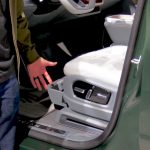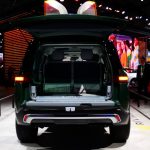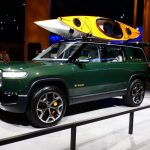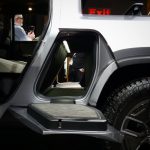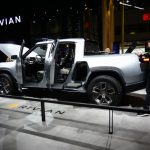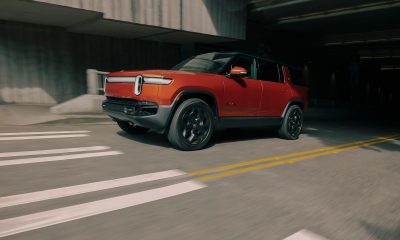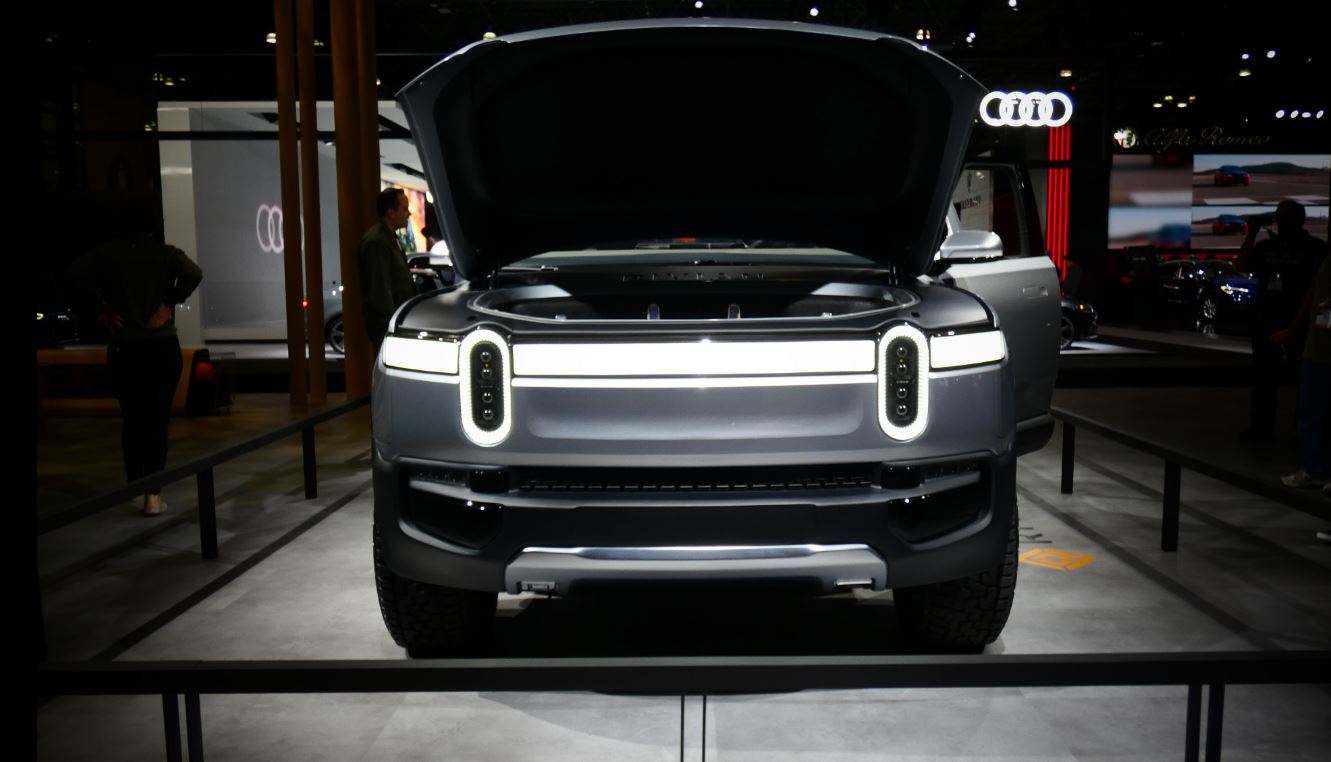

News
Rivian shows off new details at NY Auto Show before heading home
Rivian has been on a promotional whirlwind since the company came out of the shadows last year at the 2018 LA Auto Show, and with it, the all-electric adventure company’s attendance at the New York International Auto Show this year has now generated quite a few more vehicle detail revelations from interviews posted online by show attendees.
Thanks for the warm welcome, #NY! See you again soon. pic.twitter.com/RNTHh5bYy3
— Rivian (@Rivian) April 28, 2019
Brian Gase, Rivian’s Chief Engineer of Special Projects, appeared in a number of videos describing features of the R1T truck and R1S SUV that are unique and otherwise not commonly known about the vehicles.
First, the number of storage compartments were one of the smaller details that stood out. In the R1T, the back passenger seats have bins underneath the cushions, and both vehicles have sliding bins underneath the driver and shotgun seats. A full size spare tire is in the R1T bed and can be removed for even more storage if needed, but to save space for storage and its usable third row seating, the R1S has an inflatable spare tire under the trunk floor.
Rivian’s plans for interior color options were also mentioned, and there are three: Forest Edge (the green inside the demo R1T), Lunar Rock (the grey inside the demo R1S), and black. Additional premium options will be offered for interior fabrics which are already a blend of traditional materials and the types of fabrics you’d find in durable outerwear. The cabins also feature quad-zone climate control.
On the performance side, 170 kW of independent power is provided to each wheel which also provides for torque vectoring. The approximately 750-800 total horsepower in each vehicle works out to about 180 hp per wheel from each of the four motors.
- Rivian R1S SUV at New York Auto Show 2019. | Image: Dacia J. Ferris/Teslarati
- Rivian R1S SUV at New York Auto Show 2019. | Image: Dacia J. Ferris/Teslarati
- Rivian R1S SUV at New York Auto Show 2019. | Image: Dacia J. Ferris/Teslarati
Rivian’s high density battery pack, complete with a thermal control system that adapts according to charging and driving behavior, then powers the whole package. A giant battery might not seem like it would be a great choice for four-wheel adventures, but Rivian has tightly encased its vehicles’ power supply using advanced materials science to be capable of wading up to three feet of water. Since there’s no engine requiring air, only buoyancy prevents a deeper crawl.
Progress in the automotive self-driving arena is moving fast, and Rivian has already integrated that reality into the R1T and R1S designs. The camera and radar hardware on production vehicles will be capable of Level 3 autonomous driving that’s upgradable via over-the-air software updates. Rivian’s initial vehicles will ship with Level 2 capabilities and use data accumulated from its customers’ driving sent to the cloud to develop its Level 3 transition, very similar to Tesla’s strategy. Previously, Rivian has additionally suggested Jurassic Park-style autonomous tours might be available for owners wanting a guided, real-world adventure experience.
Rivian has several test mules on the road using F-150 bodies, but only one production design model of each car has been made to be used at shows and in videos.
Finally, you might know that Rivian was founded in 2009 by CEO RJ Scaringe, an MIT graduate (he holds an MS and PhD in mechanical engineering), but it seems lesser known how his personal life story is imprinted right in the company’s name. Scaringe grew up near the Indian River region of Florida, and that’s where the Rivian name is derived (RIV(er)-(Ind)IAN).

BACK TO BASICS
All of those tidbits will now join the overall more well known features driving the appeal of Rivian’s R1T truck and R1S SUV. A recap of the basics may put them into a better perspective still.
On battery packs, Rivian’s focus on outdoor adventure means that decent battery capacity and range are key components if their product ideas are to be successful, and their much-touted 180 kWh battery “megapack” boasting a 400+ mile range seems to fit that bill. The mid-range 135 kWh pack claiming a 300 mile range is also decent for well-planned routes, and it just so happens to have a fun number of 2170 battery cells – 7,777 exactly if you count the battery inside the in-door flashlight. The 135 kWh battery pack vehicles are also the versions that will do 0-60 mph in 3 seconds, although all versions are speed limited to 125 mph. A lower end 105 kWh pack with a 230 mile range will be produced last, per the usual new EV strategy of offering premium cars before more affordable variations.
https://twitter.com/PrincessDeixa/status/1118957811285811200
The first R1S and R1T deliveries are set for the end of 2020, and Rivian is currently taking preorder deposits to reserve their upcoming vehicles. Purchase prices will start at $69,000 for the R1T and $72,500 for the R1S before tax incentives.
Aside from being first to unveil a near-production all-electric pickup truck, two other features in Rivian’s electric cars have stood out. First, the quad-motor “skateboard” chassis that forms the base of current and future vehicles centralizes and simplifies Rivian’s innovations into a flexible electric car platform for its future product lines. This feature has also drawn interest from big-name partners like GM and Ford, the latter having just signed a $500 million deal with Rivian to use its tech to develop their first all-electric vehicle.
A somewhat new tidbit about the skateboard platform is the size difference between the R1S version and the R1T version. The R1S chassis is 375 mm shorter than the R1T to boost its off-road capabilities. Both vehicles’ towing capacity is around 11,000 pounds.
The second well-known feature about Rivian’s two outdoor-purposed vehicles is the amount of storage space incorporated into the designs. The frunks are spacious with a 330 mL capacity, and the R1T truck has what they call a ‘gear tunnel’, which is essentially a large cargo space tunneled through the lower middle of the truck’s cab. It looks to have the makings of the next social media photo craze, but that’s obviously speculation.
- Rivian R1T truck at the NY Auto Show 2019. | Image: Dacia J. Ferris/Teslarati
- Rivian R1T truck at the NY Auto Show 2019. | Image: Dacia J. Ferris/Teslarati
Both the frunk and tailgates have powered open and close functions for ease of use, the tailgate opening a full 180 degrees, and the bed has a powered built-in tonneau cover strong enough to support loading. Also included in the truck bed are 110V power outlets, onboard air, lights to illuminate the bed, and a gear cable that’s electronically connected to the vehicle. If the cable is cut or disconnected for any reason, the owner receives a notification on their Rivian app.
Other details to mention are the electrochromatic glass roof built into both the R1T and R1S that can change color on demand, specifically in response to outside weather and light conditions, and the daytime running lights that also act as turn signals and charging status indicator lights. A charging status indicator is also in the back of the vehicles.
Check these #rivian R1T features out! The sun roof changing colors and the height adjustable air springs in action! #NYautoshow2019 #electricvehicles #electrictruck #truck pic.twitter.com/Wc517rt8dM
— DJ (@PrincessDeixa) April 18, 2019
The last major Rivian feature to mention is the adaptable air suspension. Both vehicles’ ride height can be easily raised or lowered depending on road conditions to adjust comfort and handling characteristics. There’s even a ‘kneel’ mode to ease vehicle entry and exit.
STILL TO COME
Rivian’s R1T truck and R1S SUV already have enough innovative details to drive their consumer appeal as-is, but the company has even more developments going on in the background. Recently published patent applications have revealed a modular system for swapping out vehicle components based on activity need and a digital jerry can to extend the battery range even further for longer trips away from a charging network.
Additionally, trademark applications filed with the US Patent and Trademark Office have teased several other products in the works with names like 1C, 1A, and 2R. An interview with RJ Scaringe published by Bloomberg confirmed that Rivian is indeed working on six other products.
Details surrounding Rivian’s plans for a service network are still slim despite the abundance of other important information about the Michigan-based company. The R1S and R1T vehicles will use CCS charging ports, but whether a charging partnership or a home-grown effort is planned remains to be seen.
A NY International Auto Show attendee recently posted on Reddit details gathered from speaking with Rivian’s team, including Scaringe, and indications were made that the company is interested in using Tesla’s Superchargers, although they’ve had some difficulties with the effort. A potential roadshow tour offering test drives was also mentioned.
A couple of the Rivian video interviews can be watched below:
Elon Musk
Tesla investors will be shocked by Jim Cramer’s latest assessment
Jim Cramer is now speaking positively about Tesla, especially in terms of its Robotaxi performance and its perception as a company.

Tesla investors will be shocked by analyst Jim Cramer’s latest assessment of the company.
When it comes to Tesla analysts, many of them are consistent. The bulls usually stay the bulls, and the bears usually stay the bears. The notable analysts on each side are Dan Ives and Adam Jonas for the bulls, and Gordon Johnson for the bears.
Jim Cramer is one analyst who does not necessarily fit this mold. Cramer, who hosts CNBC’s Mad Money, has switched his opinion on Tesla stock (NASDAQ: TSLA) many times.
He has been bullish, like he was when he said the stock was a “sleeping giant” two years ago, and he has been bearish, like he was when he said there was “nothing magnificent” about the company just a few months ago.
Now, he is back to being a bull.
Cramer’s comments were related to two key points: how NVIDIA CEO Jensen Huang describes Tesla after working closely with the Company through their transactions, and how it is not a car company, as well as the recent launch of the Robotaxi fleet.
Jensen Huang’s Tesla Narrative
Cramer says that the narrative on quarterly and annual deliveries is overblown, and those who continue to worry about Tesla’s performance on that metric are misled.
“It’s not a car company,” he said.
He went on to say that people like Huang speak highly of Tesla, and that should be enough to deter any true skepticism:
“I believe what Musk says cause Musk is working with Jensen and Jensen’s telling me what’s happening on the other side is pretty amazing.”
Tesla self-driving development gets huge compliment from NVIDIA CEO
Robotaxi Launch
Many media outlets are being extremely negative regarding the early rollout of Tesla’s Robotaxi platform in Austin, Texas.
There have been a handful of small issues, but nothing significant. Cramer says that humans make mistakes in vehicles too, yet, when Tesla’s test phase of the Robotaxi does it, it’s front page news and needs to be magnified.
He said:
“Look, I mean, drivers make mistakes all the time. Why should we hold Tesla to a standard where there can be no mistakes?”
It’s refreshing to hear Cramer speak logically about the Robotaxi fleet, as Tesla has taken every measure to ensure there are no mishaps. There are safety monitors in the passenger seat, and the area of travel is limited, confined to a small number of people.
Tesla is still improving and hopes to remove teleoperators and safety monitors slowly, as CEO Elon Musk said more freedom could be granted within one or two months.
News
Tesla launches ultra-fast V4 Superchargers in China for the first time
Tesla has V4 Superchargers rolling out in China for the first time.

Tesla already has nearly 12,000 Supercharger piles across mainland China. However, the company just initiated the rollout of the ultra-fast V4 Superchargers in China for the first time, bringing its quick-charging piles to the country for the first time since their launch last year.
The first batch of V4 Superchargers is now officially up and running in China, the company announced in a post on Chinese social media outlet Weibo today.
The company said in the post:
“The first batch of Tesla V4 Superchargers are online. Covering more service areas, high-speed charging is more convenient, and six-layer powerful protection such as rain and waterproof makes charging very safe. Simultaneously open to non-Tesla vehicles, and other brands of vehicles can also be charged. There are more than 70,000 Tesla Superchargers worldwide. The charging network layout covers 100% of the provincial capitals and municipalities in mainland China. More V4 Superchargers will be put into use across the country. Optimize the charging experience and improve energy replenishment efficiency. Tesla will accompany you to the mountains, rivers, lakes, and seas with pure electricity!”
The first V4 Superchargers Tesla installed in China are available in four cities across the country: Shanghai, Zhejiang, Gansu, and Chongqing.

Credit: Tesla China
Tesla has over 70,000 Superchargers worldwide. It is the most expansive and robust EV charging network in the world. It’s the main reason why so many companies have chosen to adopt Tesla’s charging connector in North America and Europe.
In China, some EVs can use Tesla Superchargers as well.
The V4 Supercharger is capable of charging vehicles at speeds of up to 325kW for vehicles in North America. This equates to over 1,000 miles per hour of charging.
Elon Musk
Elon Musk hints at when Tesla could reduce Safety Monitors from Robotaxi
Tesla could be reducing Safety Monitors from Robotaxi within ‘a month or two,’ CEO Elon Musk says.

Elon Musk hinted at when Tesla could begin reducing Safety Monitors from its Robotaxis. Safety Monitors are Tesla employees who sit in the front passenger seat during the driverless rides, and are there to ensure safety for occupants during the earliest rides.
Tesla launched its Robotaxi fleet in Austin last Sunday, and after eight days, videos and reviews from those who have ridden in the driverless vehicles have shown that the suite is safe, accurate, and well coordinated. However, there have been a few hiccups, but nothing that has put anyone’s safety in danger.
A vast majority — close to all of the rides — at least according to those who have ridden in the Robotaxi, have been performed without any real need for human intervention. We reported on what was the first intervention last week, as a Safety Monitor had to step in and stop the vehicle in a strange interaction with a UPS truck.
Watch the first true Tesla Robotaxi intervention by safety monitor
The Tesla and UPS delivery truck were going for the same street parking space, and the Tesla began to turn into it. The UPS driver parallel parked into the spot, which was much smaller than his truck. It seemed to be more of an instance of human error instead of the Robotaxi making the wrong move. This is something that the driverless cars will have to deal with because humans are aggressive and sometimes make moves they should not.
The Safety Monitors have not been too active in the vehicles. After all, we’ve only seen that single instance of an intervention. There was also an issue with the sun, when the Tesla braked abnormally due to the glare, but this was an instance where the car handled the scenario and proceeded normally.
With the Robotaxi fleet operating impressively, some are wondering when Tesla will begin scaling back both the Safety Monitors and Teleoperators that it is using to ensure safety with these early rides.
CEO Elon Musk answered the inquiry by stating, “As soon as we feel it is safe to do so. Probably within a month or two.”
As soon as we feel it is safe to do so.
Probably within a month or two. We continue to improve the Tesla AI with each mile driven.
— Elon Musk (@elonmusk) June 30, 2025
Musk’s response seems to confirm that there will be fewer Teleoperators and Safety Monitors in the coming months, but there will still be some within the fleet to ensure safety. Eventually, that number will get to zero.
Reaching a point where Tesla’s Robotaxi is driverless will be another significant milestone for the company and its path to fully autonomous ride-sharing.
Eventually, Tesla will roll out these capabilities to consumer-owned vehicles, offering them a path to generate revenue as their car operates autonomously and completes rides.
For now, Tesla is focusing on perfecting the area of Austin where it is currently offering driverless rides for just $4.20 to a small group of people.
-

 News5 days ago
News5 days agoTesla Robotaxi’s biggest challenge seems to be this one thing
-

 News2 weeks ago
News2 weeks agoTesla confirms massive hardware change for autonomy improvement
-

 Elon Musk2 weeks ago
Elon Musk2 weeks agoElon Musk slams Bloomberg’s shocking xAI cash burn claims
-

 News2 weeks ago
News2 weeks agoTesla China roars back with highest vehicle registrations this Q2 so far
-

 News2 weeks ago
News2 weeks agoTesla features used to flunk 16-year-old’s driver license test
-

 News2 weeks ago
News2 weeks agoTexas lawmakers urge Tesla to delay Austin robotaxi launch to September
-

 News2 weeks ago
News2 weeks agoTesla dominates Cars.com’s Made in America Index with clean sweep
-

 News2 weeks ago
News2 weeks agoTesla’s Grok integration will be more realistic with this cool feature

